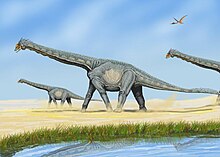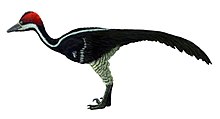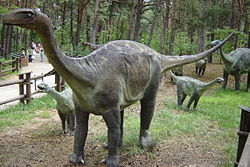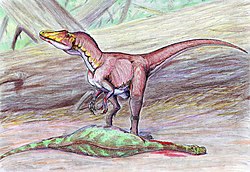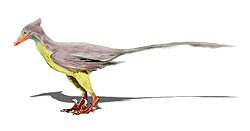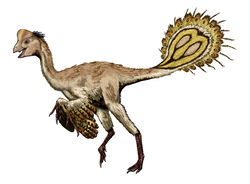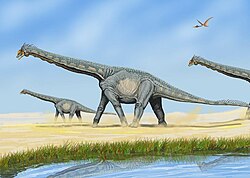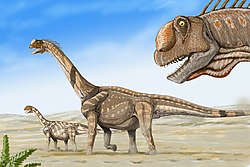Systematik der Dinosaurier

Die Dinosaurier sind ein Taxon der Archosaurier innerhalb der Sauropsiden (Sauropsida) bzw. Reptilien (Reptilia). Gemeinsam mit ihrer Schwestergruppe, den Flugsauriern (Pterosauria), bilden sie das Taxon der Ornithodira. Diese Systematik der Dinosaurier wurde nach den unter Literatur, Einzelnachweise und Weblinks aufgeführten Quellen erstellt.
Nach der 1887 durch Harry Govier Seeley[1] vom King’s College London eingeführten und lange prägenden Systematik wurden Dinosaurier in die beiden Ordnungen beziehungsweise Entwicklungslinien Echsenbeckensaurier (Saurischia) und Vogelbeckensaurier (Ornithischia) unterteilt. In einer phylogenetischen Studie aus dem Jahr 2017, basierend auf der detaillierten Analyse von 74 Taxa und 457 Merkmalen, schlagen die Paläontologen Matthew G. Baron, David B. Norman und Paul M. Barrett eine neue Systematik vor, die den Dinosaurier-Stammbaum radikal verändert.[2][3][4][5] Demnach bestehen die Dinosaurier aus den beiden Entwicklungslinien Saurischia und Ornithoscelida. In der Klade Ornithoscelida (gr. skelis=Bein), die Thomas Henry Huxley bereits 1880 so benannt hatte,[6] werden die Vogelbeckensaurier und die Theropoden als Schwestergruppen vereint. Die Klade Saurischia wird neu definiert und umfasst die beiden Schwestergruppen Sauropodomorpha und Herrerasauridae:
| Dinosauria |
| ||||||||||||||||||
Vogelbeckendinosaurier (Ornithischia)


- Eocursor
- Lesothosaurus
- Pisanosaurus
- Heterodontosauridae[7]
- Thyreophora
- Cerapoda

- Abrictosaurus
- Echinodon
- Fruitadens
- Heterodontosaurus
- Lanasaurus
- Lycorhinus
- Manidens
- Pegomastax
- Tianyulong



- Huayangosauridae
- Stegosauridae
- Chungkingosaurus?
- Dacentrurus
- Stegosaurinae
- Chialingosaurus
- Craterosaurus
- Dravidosaurus (umstritten)
- Hesperosaurus
- Kentrosaurus
- Lexovisaurus
- Monkonosaurus
- Paranthodon
- Stegosaurus
- Tuojiangosaurus
- Wuerhosaurus
- Stegosauria incertae sedis
- Gigantspinosaurus
- Jiangjunosaurus
- Regnosaurus
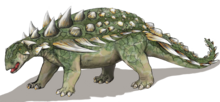





- Ankylosauridae
- Nodosauridae
- Animantarx
- Cedarpelta
- Edmontonia
- Glyptodontopelta[9]
- Hungarosaurus
- Panoplosaurus
- Pawpawsaurus
- Peloroplites[10]
- Sauropelta
- Silvisaurus
- Struthiosaurus
- Zhejiangosaurus
- Zhongyuansaurus
- Ankylosauria incertae sedis und nomina dubia
- Acanthopholis
- Aletopelta
- Anoplosaurus
- Antarctopelta
- Bissektipelta
- Crichtonsaurus
- Dracopelta
- Hoplitosaurus
- Hylaeosaurus
- Liaoningosaurus
- Mymoorapelta
- Niobrarasaurus
- Nodosaurus
- Polacanthus
- Sarcolestes
- Sauroplites
- Shanxia
- Stegopelta
- Texasetes

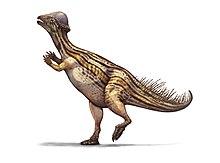
- Ferganocephale (umstritten)
- Stenopelix (umstritten)
- Wannanosaurus
- Yaverlandia (umstritten)
- Goyocephala
- Goyocephale
- Homalocephaloidea
- Homalocephale
- Ornatotholus
- Pachycephalosauridae
- Acrotholus[11]
- Alaskacephale
- Colepiocephale
- Dracorex
- Gravitholus
- Hanssuesia
- Pachycephalosaurus
- Prenocephale
- Sphaerotholus
- Stegoceras
- Stygimoloch
- Texacephale[12]
- Tylocephale

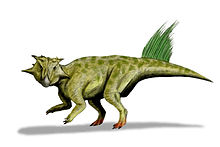




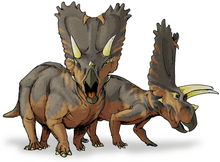

- Yinlong
- Chaoyangsauridae (evtl. in Neoceratopsia?)
- Psittacosauridae
- Neoceratopsia
- Archaeoceratops
- Auroraceratops
- Cerasinops
- Koreaceratops[13]
- Liaoceratops
- Yamaceratops
- Protoceratopsidae
- Bagaceratops
- Bainoceratops ?
- Breviceratops ?
- Graciliceratops
- Lamaceratops ?
- Magnirostris ?
- Platyceratops ?
- Protoceratops
- Udanoceratops
- Leptoceratopsidae
- Leptoceratops
- Montanoceratops
- Prenoceratops
- Zuniceratops
- Ceratopsidae
- Centrosaurinae
- Achelousaurus
- Albertaceratops
- Avaceratops
- Brachyceratops ?
- Centrosaurus
- Diabloceratops[14]
- Einiosaurus
- Monoclonius ?
- Nasutoceratops
- Pachyrhinosaurus
- Rubeosaurus[15]
- Sinoceratops[16]
- Spinops[17]
- Styracosaurus
- Wendiceratops[18]
- Xenoceratops
- Chasmosaurinae
- Agujaceratops
- Anchiceratops
- Arrhinoceratops
- Chasmosaurus
- Coahuilaceratops
- Diceratus
- Eotriceratops
- Kosmoceratops[19]
- Medusaceratops
- Mojoceratops
- Ojoceratops
- Pentaceratops
- Tatankaceratops
- Titanoceratops[20]
- Torosaurus
- Triceratops
- Utahceratops[19]
- Vagaceratops[19]
- Centrosaurinae
- Ceratopsia incertae sedis und Nomina dubia
- Agathaumas
- Asiaceratops
- Ceratops
- Dysganus
- Kulceratops
- Microceratus
- Notoceratops
- Polyonax
- Serendipaceratops
- Turanoceratops
- Ugrosaurus





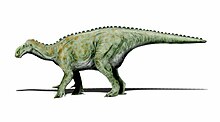





- Agilisaurus
- Alocodon
- Anabisetia
- Atlascopcosaurus
- Bugenasaurua
- Drinker
- Fulgurotherium
- Gasparinisaura
- Hypsilophodon
- Jeholosaurus
- Leaellynasaura
- Notohypsilophodon
- Orodromeus
- Othnielia
- Parksosaurus
- Qantassaurus
- Thescelosaurus
- Yandusaurus
- Zephyrosaurus
- Iguanodontia
- Rhabdodon
- Talenkauen[21]
- Tenontosaurus
- Zalmoxes
- Dryomorpha
- Dryosauridae
- Callovosaurus
- Dryosaurus
- Dysalotosaurus
- Kangnasaurus
- Planicoxa
- Valdosaurus
- Ankylopollexia
- Camptosaurus
- Draconyx
- Theiophytalia[22]
- Iguanodontoidea
- Altirhinus
- Craspedodon
- Eolambia
- Equijubus
- Fukuisaurus
- Iguanodon
- Jinzhousaurus
- Lurdusaurus
- Muttaburrasaurus
- Nanyangosaurus
- Ouranosaurus
- Probactrosaurus
- Protohadros
- Shuangmiaosaurus
- Hadrosauridae
- Bactrosaurus
- Claosaurus
- Gilmoreosaurus
- Secernosaurus
- Tanius
- Telmatosaurus
- Euhadrosauria
- Hadrosaurinae
- Anasazisaurus
- Anatotitan
- Aralosaurus
- Brachylophosaurus
- Edmontosaurus
- Gryposaurus
- Hadrosaurus
- Kritosaurus
- Lophorhotodon
- Maiasaura
- Naashoibitosaurus
- Prosaurolophus
- Saurolophus
- Shantungosaurus
- Lambeosaurinae
- Amurosaurus
- Barsboldia
- Charonosaurus
- Corythosaurus
- Hypacrosaurus
- Jaxartosaurus
- Lambeosaurus
- Nipponosaurus
- Olorotitan
- Parasaurolophus
- Tsintaosaurus
- Velafrons
- Hadrosaurinae
- Dryosauridae
Echsenbeckendinosaurier (Saurischia)


- Herrerasauridae
- Herrerasaurus
- Sanjuansaurus[23]
- Staurikosaurus
- Eoraptor
- Guaibasaurus
- Saturnalia
- Saurischia incertae sedis
- Alwalkeria
- Chindesaurus
- Sauropodomorpha
- Efraasia
- Panphagia
- Sarahsaurus
- Thecodontosaurus
- Prosauropoda
- Sauropoda
- Theropoda


- Ruehlia ?
- Saturnalia
- Thecodontosaurus
- Yimenosaurus ?
- Anchisauria
- Plateosauria
- Coloradisaurus
- Euskelosaurus
- „Gyposaurus“
- Jingshanosaurus
- Lufengosaurus
- Massospondylus
- Mussaurus
- Plateosaurus
- Unaysaurus[25]
- Yunnanosaurus







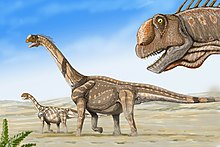

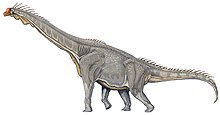
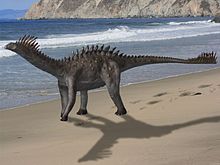





- Blikanasaurus
- Gongxianosaurus
- Isanosaurus
- Kotasaurus
- Ohmdenosaurus
- Pulanesaura
- Spinophorosaurus
- Vulcanodontidae
- Sauropoda incertae sedis
- Cardiodon
- Datousaurus
- Dystrophaeus
- Klamelisaurus
- Oplosaurus
- Rhoetosaurus
- Tendaguria
- Volkheimeria
- Eusauropoda
- Barapasaurus
- Chuanjiesaurus
- Eomamenchisaurus
- Haplocanthosaurus
- Lourinhasaurus
- Mamenchisaurus
- Omeisaurus
- Shunosaurus
- Tehuelchesaurus
- Tienshanosaurus
- Tonganosaurus
- Yuanmousaurus
- Cetiosauridae
- Eusauropoda incerta sedis
- Agrosaurus
- Amygdalodon
- Aragosaurus
- Hudiesaurus
- Neosauropoda
- Diplodocoidea
- Suuwassea
- Rebbachisauridae
- Cathartesaura
- Nigersaurus
- Rayososaurus
- Rebbachisaurus
- Limaysaurus[26]
- Dicraeosauridae
- Diplodocidae
- Apatosaurus = Brontosaurus
- Barosaurus
- Diplodocus
- Diplodocoidea incerta sedis
- Amphicoelias
- Cetiosauriscus
- Dinheirosaurus
- Losillasaurus
- Seismosaurus[27]
- Macronaria
- Atlasaurus
- Bellusaurus
- Europasaurus
- Jobaria
- Macronaria incerta sedis
- Abrosaurus
- Camarasauromorpha
- Camarasauridae
- Titanosauriformes
- Astrodon
- Australodocus[28]
- Lapparentosaurus
- Ornithopsis
- Pelorosaurus
- Wintonotitan[29]
- Familie Brachiosauridae
- Abydosaurus
- ?Bothriospondylus
- Brachiosaurus
- Cedarosaurus
- ?Daanosaurus
- Giraffatitan
- ?„Ischyrosaurus“
- Lusotitan
- ?Paluxysaurus
- ?Pleurocoelus
- Sauroposeidon
- Sonorasaurus
- Familie Huanghetitanidae
- Huanghetitan
- Somphospondyli
- Familie Euhelopodidae
- Titanosauria[32]
- Adamantisaurus[33]
- Aegyptosaurus
- Agustinia
- Amargatitanis[34]
- Andesaurus
- Argentinosaurus
- Argyrosaurus
- Austrosaurus
- Baurutitan[35]
- Chubutisaurus
- Epachthosaurus
- Gobititan[36]
- Huabeisaurus
- Janenschia
- Karongasaurus[37]
- Ligabuesaurus[38]
- Maxakalisaurus[39]
- Phuwiangosaurus
- Sonidosaurus[40]
- Tangvayosaurus
- Uberabatitan[41]
- Venenosaurus
- Lithostrotia
- Aeolosaurus
- Alamosaurus
- Ampelosaurus
- Antarctosaurus
- Atsinganosaurus[42]
- Bonitasaura[43]
- Borealosaurus[44]
- Diamantinasaurus
- Futalognkosaurus
- Gondwanatitan
- Isisaurus[45]
- Iuticosaurus[46]
- Jainosaurus
- Jiangshanosaurus
- Laplatasaurus
- Lirainosaurus
- Magyarosaurus
- Malawisaurus
- Mendozasaurus[47]
- Mongolosaurus
- Muyelensaurus[48]
- Nemegtosaurus
- Paralititan
- Pellegrinisaurus
- Puertasaurus[49]
- Quaesitosaurus
- Rapetosaurus
- Rinconsaurus[50]
- Rocasaurus
- Traukutitan[51]
- Trigonosaurus
- Saltasauridae
- Nomina dubia (zweifelhafte Gattungen)
- Bruhathkayosaurus
- Hypselosaurus
- Titanosaurus[45]
- Diplodocoidea

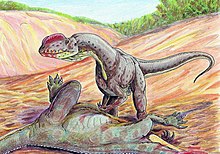

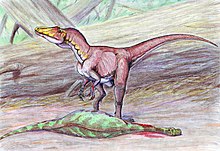



- Coelophysoidea
- Zupaysaurus
- Dilophosauridae
- Neoceratosauria
- Tetanurae
- Chilesaurus[53]
- Megaraptor
- Xuanhanosaurus
- Spinosauroidea (Megalosauroidea)
- Tetanurae incertae sedis
- Becklespinax
- Erectopus
- Iliosuchus
- Kaijiangosaurus
- Kelmayisaurus
- Magnosaurus
- Piveteausaurus
- Rapator
- Sigilmassasaurus
- Streptospondylus
- Avetheropoda
- Avetheropoda incertae sedis
- Bahariasaurus
- Gasosaurus
- Ozraptor
- Quilmesaurus
- Shanyangosaurus
- Valdoraptor
- Carnosauria
- Coelurosauria[54]
- Coelurosauria incertae sedis
- Archaeornithoides
- Deltadromeus
- Kakuru
- Nedcolbertia
- Nqwebasaurus
- Ricardoestesia
- Scipionyx
- Tugulusaurus
- Compsognathidae
- Aristosuchus
- Compsognathus
- Huaxiagnathus
- Juravenator
- Mirischia
- Sinocalliopteryx
- Sinosauropteryx
- Coeluridae[54]
- Coelurus
- Tanycolagreus
- Tyrannosauroidea
- Maniraptoriformes
- Coelurosauria incertae sedis
- Avetheropoda incertae sedis

- Camposaurus
- Coelophysis
- Gojirasaurus
- Liliensternus
- Megapnosaurus
- Podokesaurus
- Procompsognathus
- Sarcosaurus
- Segisaurus

- Ceratosaurus
- Elaphrosaurus
- Abelisauroidea
- Berberosaurus[55]
- Noasauridae
- Laevisuchus
- Masiakasaurus
- Noasaurus
- Velocisaurus
- Abelisauridae
- Abelisaurus
- Aucasaurus
- Carnotaurus
- Ekrixinatosaurus
- Ilokelesia
- Indosaurus
- Kryptops
- Lametasaurus
- Majungasaurus
- Rahiolisaurus
- Rajasaurus
- Rugops
- Skorpiovenator
- Vitakridrinda
- Xenotarsosaurus
- Neoceratosauria incertae sedis
- Genusaurus
- Indosuchus
- Ligabueino
- Ceratosauria incertae sedis


- Sciurumimus
- Megalosauridae
- Megalosaurinae
- Megalosaurus
- Poekilopleuron
- Torvosaurus
- Eustreptospondylinae
- Megalosaurinae
- Spinosauridae
- Baryonychinae
- Baryonyx
- Cristatusaurus
- Ichthyovenator[57]
- Suchomimus
- Spinosaurinae
- Angaturama
- Irritator
- Oxalaia
- Spinosaurus
- Baryonychinae


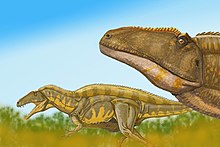
- Lourinhanosaurus
- Monolophosaurus
- Siamotyrannus
- Allosauroidea



- Appalachiosaurus
- Aviatyrannis[61]
- Bagarataan
- Bistahieversor
- Dilong[62]
- Dryptosaurus
- Eotyrannus
- Raptorex
- Stokesosaurus
- Xiongguanlong
- Yutyrannus
- Proceratosauridae[63]
- Guanlong[64]
- Kileskus[65]
- Proceratosaurus
- Sinotyrannus[66]
- Tyrannosauridae
- Tyrannosauroidea incertae sedis
- Mögliche Tyrannosauroidea
- Itemirus
- Labocania
- Santanaraptor

- Beishanlong[67]
- Garudimimus
- Harpymimus
- Pelecanimimus
- Shenzhousaurus
- Ornithomimidae
- Anserimimus
- Archaeornithomimus
- Gallimimus
- Ornithomimus (einschließlich Dromiceiomimus)
- Sinornithomimus
- Struthiomimus
- Status unklar
- Coelosaurus
- Deinocheirus
- Timimus
- Alxasaurus
- Beipiaosaurus
- Enigmosaurus[68]
- Falcarius
- Nanshiungosaurus
- Suzhousaurus
- Therizinosauridae
- Erliansaurus
- Erlikosaurus
- ?Eshanosaurus
- Neimongosaurus
- Nothronychus
- Segnosaurus
- Therizinosaurus
Alvarezsauroidea

- Haplocheirus[69]
- Alvarezsauridae
- Achillesaurus
- Albertonykus
- Alvarezsaurus
- Patagonykus
- Mononykinae

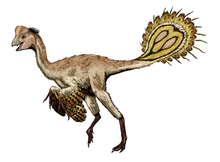

- Avimimus
- Caudipteryx
- Incisivosaurus
- Similicaudipteryx
- Caenagnathoidea
- Hagryphus
- Caenagnathidae
- Oviraptoridae
- Banji
- Gigantoraptor[70]
- Luoyanggia
- Microvenator
- Shixinggia
- Ingeniinae
- Ajancingenia
- Conchoraptor
- Heyuannia
- Khaan
- Oviraptorinae
- Anchiornis
- Borogovia
- Byronosaurus
- Jinfengopteryx[71]
- Mei
- Saurornithoides
- Sinornithoides
- Sinovenator
- Tochisaurus
- Troodon
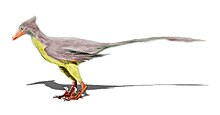



- Mahakala
- Unenlagiinae
- Microraptorinae
- Saurornitholestinae
- Velociraptorinae
- Dromaeosaurinae
- Status unklar
- Dromaeosauroides
- Koparion[74]
- Luanchuanraptor
- Pedopenna[75]
- Pyroraptor
- Unquillosaurus
- Variraptor
Avialae (Vögel i. w. S.)
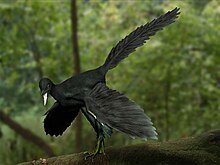
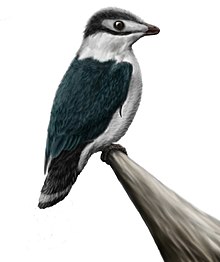
- Scansoriopterygidae
- Epidexipteryx
- Epidendrosaurus
- Yi
- Archaeopterygidae
- Pygostylia
- Confuciusornithidae
- Changchengornis
- Confuciusornis
- Eoconfuciusornis[76]
- Jinzhouornis[77]
- Ornithothoraces
- Kuszholia
- Patagopteryx
- Vorona
- Enantiornithes
- Ornithurae
- Hesperornithiformes
- Ichthyornithiformes
- Neuzeitliche Vögel (Neornithes)
- Confuciusornithidae
Siehe auch: Biologische Systematik, Systematik der Vögel, Gefiederte Dinosaurier
Literatur
- David B. Weishampel, Peter Dodson, Halszka Osmólska (Hrsg.): The Dinosauria. 2nd edition. University of California Press, Berkeley, Calif. u. a. 2004, ISBN 0-520-24209-2.
- Thomas R. Holtz Jr.: Classification and Evolution of the Dinosaur Groups. In: Gregory S. Paul: The Scientific American Book of Dinosaurs. St. Martin’s Press, New York NY 2000, ISBN 0-312-26226-4.
Weblinks
- Dinosaur Genus List (PDF; 188 kB) – Supplementary Information to Dinosaurs by Thomas R. Holtz – Stand: 31. Juli 2008. Ergänzende Informationen hier (en.; PDF-Datei; 184 kB)
- Dinosaur Supertree 2008 (Berücksichtigt 440 Arten, en.)
- A genus-level supertree of the Dinosauria (2002) (Berücksichtigt 277 Gattungen, PDF-Datei, en.; 272 kB)
- Dinosauria beim TOL (en.)
- Thomas R. Holtz: A new phylogeny of the carnivorous dinosaurs (PDF-Datei; 833 kB)
Einzelnachweise
- ↑ Harry G. Seeley: The classification of the Dinosauria. In: Report of the Fifty-Seventh Meeting of the British Association for the Advancement of Science held at Manchester in August and September 1887. ISSN 0262-690X, S. 698–699, Digitalisat.
- ↑ K Padian: Palaeontology: Dividing the dinosaurs. In: Nature. 543. Jahrgang, 2017, S. 494–495, PMID 28332523 (nature.com).
- ↑ MG Baron, Norman DB, Barrett PM: A new hypothesis of dinosaur relationships and early dinosaur evolution. In: Nature. 543. Jahrgang, 2017, S. 501–506, PMID 28332513.
- ↑ Alexandra Grass: Paläontologie. Dino-Stammbaum neu. Wiener Zeitung, 23. März 2017, abgerufen am 17. April 2017.
- ↑ Frank Patalong: Neuordnung. Studie stellt Dinosaurier-Stammbaum in Frage. Spiegel Online, 23. März 2017, abgerufen am 17. April 2017.
- ↑ TH Huxley: On the classification of the Dinosauria with observations on the Dinosauria of the Trias. In: Q J Geol Soc. 26. Jahrgang, 1880, S. 32–51.
- ↑ Richard J. Butler, Paul Upchurch, David B. Norman: The phylogeny of the ornithischian dinosaurs. In: Journal of Systematic Palaeontology. Bd. 6, Nr. 1, 2008, ISSN 1477-2019, S. 1–40, doi:10.1017/S1477201907002271.
- ↑ Clifford A. Miles, Clark J. Miles: Skull of Minotaurasaurus ramachandrani, a new Cretaceous ankylosaur from the Gobi Desert. In: Current Science. Bd. 96, Nr. 1, 2009, ISSN 0011-3891, S. 65–70, online (PDF; 1,04 MB).
- ↑ Michael E. Burns: Taxonomic utility of ankylosaur (Dinosauria, Ornithischia) osteoderms: Glyptodontopelta mimus Ford, 2000: a test case. In: Journal of Vertebrate Paleontology. Bd. 28, Nr. 4, 2008, ISSN 0272-4634, S. 1102–1109, doi:10.1671/0272-4634-28.4.1102.
- ↑ Kenneth Carpenter, Jeff Bartlett, John Bird, Reese Barrick: Ankylosaurs from the Price River Quarries, Cedar Mountain Formation (Lower Cretaceous), east-central Utah. In: Journal of Vertebrate Paleontology. Bd. 28, Nr. 4, 2008, S. 1089–1101, doi:10.1671/0272-4634-28.4.1089.
- ↑ David C. Evans, Ryan K. Schott, Derek W. Larson, Caleb M. Brown, Michael J. Ryan: The oldest North American pachycephalosaurid and the hidden diversity of small-bodied ornithischian dinosaurs. In: Nature Communications. Bd. 4, Article Nr. 1828, 2013, doi:10.1038/ncomms2749.
- ↑ Nicholas R. Longrich, Julia Sankey, Darren Tanke: Texacephale langstoni, a new genus of pachycephalosaurid (Dinosauria: Ornithischia) from the upper Campanian Aguja Formation, southern Texas, USA. In: Cretaceous Research. Bd. 31, Nr. 2, 2010, ISSN 0195-6671, S. 274–284, doi:10.1016/j.cretres.2009.12.002.
- ↑ Yuong-Nam Lee, Michael J. Ryan, Yoshitsugu Kobayashi: The first ceratopsian dinosaur from South Korea. In: Naturwissenschaften. Bd. 98, Nr. 1, 2010, S. 39–49, doi:10.1007/s00114-010-0739-y.
- ↑ James I. Kirkland, Donald D. DeBlieux: New basal centrosaurine ceratopsian skulls from the Wahweap Formation (Middle Campanian), Grand Staircase–Escalante National Monument, southern Utah. In: Michael J. Ryan, Brenda J. Chinnery-Allgeier, David A. Eberth (Hrsg.): New Perspectives on Horned Dinosaurs. The Royal Tyrrell Museum Ceratopsian Symposium. Indiana University Press, Bloomington IN 2010, ISBN 978-0-253-35358-0, S. 117–140.
- ↑ Andrew T. McDonald, John R. Horner: New Material of „Styracosaurus“ ovatus from the Two Medicine Formation of Montana. In: Michael J. Ryan, Brenda J. Chinnery-Allgeier, David A. Eberth (Hrsg.): New Perspectives on Horned Dinosaurs. The Royal Tyrrell Museum Ceratopsian Symposium. Indiana University Press, Bloomington IN 2010, ISBN 978-0-253-35358-0, S. 156–168.
- ↑ Xing Xu, KeBai Wang, XiJin Zhao, DunJing Li: First ceratopsid dinosaur from China and its biogeographical implications. In: Chinese Science Bulletin. Bd. 55, Nr. 16, 2010, ISSN 0250-7862, S. 1631–1635, doi:10.1007/s11434-009-3614-5.
- ↑ Andrew A. Farke, Michael J. Ryan, Paul M. Barrett, Darren H. Tanke, Dennis R. Braman, Mark A. Loewen, Mark R. Graham: A new centrosaurine from the Late Cretaceous of Alberta, Canada, and the evolution of parietal ornamentation in horned dinosaurs. In: Acta Palaeontologica Polonica. Bd. 56, Nr. 4, 2011, ISSN 0567-7920, S. 691–702, doi:10.4202/app.2010.0121.
- ↑ David C. Evans, Michael J. Ryan. Cranial Anatomy of Wendiceratops pinhornensis gen. et sp. nov., a Centrosaurine Ceratopsid (Dinosauria: Ornithischia) from the Oldman Formation (Campanian), Alberta, Canada, and the Evolution of Ceratopsid Nasal Ornamentation. PLOS ONE, 2015; 10 (7): e0130007 DOI: 10.1371/journal.pone.0130007
- ↑ a b c Scott D. Sampson, Mark A. Loewen, Andrew A. Farke, Eric M. Roberts, Catherine A. Forster, Joshua A. Smith, Alan L. Titus: New Horned Dinosaurs from Utah Provide Evidence for Intracontinental Dinosaur Endemism. In: PLoS ONE. Bd. 5, Nr. 9, 2010, ISSN 1932-6203, S. e12292, doi:10.1371/journal.pone.0012292.
- ↑ Nicholas R. Longrich: Titanoceratops ouranous, a giant horned dinosaur from the Late Campanian of New Mexico. In: Cretaceous Research. Bd. 32, Nr. 3, 2011, S. 264–276, doi:10.1016/j.cretres.2010.12.007.
- ↑ Fernando E. Novas, Andrea V. Cambiaso, Alfredo Ambrioso: A new basal iguanodontian (Dinosauria, Ornithischia) from the Upper Cretaceous of Patagonia. In: Ameghiniana. Bd. 41, Nr. 1, 2004, ISSN 0002-7014, S. 75–82.
- ↑ Gregory S. Paul: The Princeton Field Guide To Dinosaurs. Princeton University Press, Princeton NJ 2010, ISBN 978-0-691-13720-9, S. 285, Online.
- ↑ Oscar A. Alcober, Ricardo N. Martinez: A new herrerasaurid (Dinosauria, Saurischia) from the Upper Triassic Ischigualasto Formation of northwestern Argentina. In: Zookeys. Bd. 63, 2010, ISSN 1313-2989, S. 55–81, doi:10.3897/zookeys.63.550.
- ↑ Adam M. Yates, Matthew F. Bonnan, Johann Neveling, Anusuya Chinsamy, Marc G. Blackbeard: A new transitional sauropodomorph dinosaur from the Early Jurassic of South Africa and the evolution of sauropod feeding and quadrupedalis. In: Proceedings of the Royal Society. Series B: Biological Sciences. Bd. 277, Nr. 1682, 2010, ISSN 0950-1193, S. 787–794, doi:10.1098/rspb.2009.1440.
- ↑ Luciano A. Leal, Sergio A. K. Azevodo, Alexander W. A. Kellner, Átila A. S. da Rosa: A new early dinosaur (Sauropodomorpha) from the Caturrita Formation (Late Triassic), Paraná Basin, Brazil. In: Zootaxa. Bd. 690, October 18 2004, ISSN 1175-5326, S. 1–24, Abstract online (PDF; 12 kB).
- ↑ John A. Whitlock: A phylogenetic analysis of Diplodocoidea (Saurischia: Sauropoda). In: Zoological Journal of the Linnean Society. Bd. 161, Nr. 4, 2011, ISSN 0024-4082, S. 872–915, doi:10.1111/j.1096-3642.2010.00665.x.
- ↑ Spencer G. Lucas, Matthew C. Herne, Andrew B. Heckert, Adrian P. Hunt, Robert M. Sullivan:Reappraisal of Seismosaurus, a Late Jurassic sauropod dinosaur from New Mexico. ( vom 8. Oktober 2019 im Internet Archive) 2004.
- ↑ John A. Whitlock: Re-evaluation of Australodocus bohetii, a putative diplodocoid sauropod from the Tendaguru Formation of Tanzania, with comment on Late Jurassic sauropod faunal diversity and palaeoecology. In: Palaeogeography, Palaeoclimatology, Palaeoecology. 309, Nr. 3/4, 2011, ISSN 0031-0182, S. 333–341, doi:10.1016/j.palaeo.2011.07.001.
- ↑ Scott A. Hocknull, Matt A. White, Travis R. Tischler, Alex G. Cook, Naomi D. Calleja, Trish Sloan, David A. Elliott: New Mid-Cretaceous (Latest Albian) Dinosaurs from Winton, Queensland, Australia. In: PLoS ONE. Bd. 4, Nr. 7, 2009, S. e6190, doi:10.1371/journal.pone.0006190.
- ↑ Hai-Lu You, Da-Qing Li: The first well-preserved Early Cretaceous brachiosaurid dinosaur in Asia. In: Proceedings of the Royal Society. Series B: Biological Sciences. Bd. 276, Nr. 1675, 2009, S. 4077–4082, doi:10.1098/rspb.2009.1278.
- ↑ Gregory S. Paul: The Princeton Field Guide To Dinosaurs. Princeton University Press, Princeton NJ u. a. 2010, ISBN 978-0-691-13720-9, S. 204, Online.
- ↑ Kristina Curry Rogers: Titanosauria. A Phylogenetic Overview. In: Kristina Curry Rogers, Jeffrey A. Wilson (Hrsg.): The Sauropods. Evolution and Paleobiology. University of California Press, Berkeley CA u. a. 2005, ISBN 0-520-24623-3, S. 50–103.
- ↑ Rodrigo Miloni Santucci, Reinaldo J. Bertini: A new titanosaur from western São Paulo State, Upper Cretaceous Bauru Group, south-east Brazil. In: Palaeontology. Bd. 49, Nr. 1, 2006, ISSN 0031-0239, S. 59–66, doi:10.1111/j.1475-4983.2005.00527.x.
- ↑ Sebastián Apesteguía: The sauropod diversity of the La Amarga Formation (Barremian), Neuquén (Argentina). In: Gondwana Research. Bd. 12, Nr. 4, 2007, ISSN 1342-937X, S. 533–546, doi:10.1016/j.gr.2007.04.007.
- ↑ Alexander Wilhelm Armin Kellner, Diogenes de Almeida Campos, Marcelo N. F. Trotta: Description of a titanosaurid caudal series from the Bauru Group, Late Cretaceous of Brazil. In: Arquivos do Museu Nacional. Rio de Janeiro. Bd. 63, Nr. 3, 2005, ISSN 0365-4508, S. 529–564,online (PDF; 1,59 MB) ( vom 18. Juli 2014 im Internet Archive).
- ↑ Hailu You, Feng Tang, Zhexi Luo: A New Basal Titanosaur (Dinosauria: Sauropoda) from the Early Cretaceous of China. In: Acta Geologica Sinica. Bd. 77, Nr. 4, 2003, ISSN 1000-9515, S. 424–429, doi:10.1111/j.1755-6724.2003.tb00123.x.
- ↑ Elizabeth M. Gomani: Sauropod dinosaurs from the Early Cretaceous of Malawi, Africa. In: Palaeontologia Electronica. Bd. 8, Nr. 1, 2005, ISSN 1094-8074, S. 1–37, online (PDF; 6,91 MB).
- ↑ José F. Bonaparte, Bernardo J. González Riga, Sebastián Apesteguía: Ligabuesaurus leanzai gen. et sp. nov. (Dinosauria, Sauropoda), a new titanosaur from the Lohan Cura Formation (Aptian, Lower Cretaceous) of Neuquén, Patagonia, Argentina. In: Cretaceous Research. Bd. 27, Nr. 3, 2006, S. 364–376, doi:10.1016/j.cretres.2005.07.004.
- ↑ Alexander W. A. Kellner, Diogenes de Almeida Campos, Sergio A. K. de Azevedo, Marcelo N. F. Trotta, Deise D. R. Henriques, Maureen M. T. Craik, Helder de Paula Silva: On a new titanosaur sauropod from the Bauru Group, Late Cretaceous of Brazil. In: Boletim do Museu Nacional. Geologia. Nr. 74, 2006, ISSN 0080-3200, S. 1–31,online (PDF; 3,31 MB) ( vom 15. März 2007 im Internet Archive).
- ↑ Xing Xu, Xiaohong Zhang, Qingwei Tan, Xijin Zhao, Lin Tan: A new titanosaurian sauropod from Late Cretaceous of Nei Mongol, China. In: Acta Geologica Sinica. Bd. 80, Nr. 1, 2006, S. 20–26, doi:10.1111/j.1755-6724.2006.tb00790.x.
- ↑ Leonardo Salgado, Ismar de Souza Carvalho: Uberabatitan ribeiroi, a new titanosaur from the Marila Formation (Bauru Group, Upper Cretaceous), Minas Gerais, Brazil. In: Palaeontology. Bd. 51, Nr. 4, 2008, S. 881–901, doi:10.1111/j.1475-4983.2008.00781.x.
- ↑ Géraldine Garcia, Sauveur Amico, François Fournier, Eudes Thouand, Xavier Valentin: A new Titanosaur genus (Dinosauria, Sauropoda) from the Late Cretaceous of southern France and its paleobiogeographic implications. In: Bulletin de la Societe Geologique de France. Bd. 181, Nr. 3, 2010, ISSN 0037-9409, S. 269–277, doi:10.2113/gssgfbull.181.3.269.
- ↑ Sebastián Apesteguía: Bonitasaura salgadoi gen. et sp. nov.: a beaked sauropod from the Late Cretaceous of Patagonia. In: Naturwissenschaften. Bd. 91, Nr. 10, 2004, S. 493–497, doi:10.1007/s00114-004-0560-6.
- ↑ Hailu You, Qiang Ji, Matthew C. Lamanna, Jinglu Li, Yinxian Li: A Titanosaurian Sauropod Dinosaur with Opisthocoelous Caudal Vertebrae from the Early Late Cretaceous of Liaoning Province, China. In: Acta Geologica Sinica. Bd. 78, Nr. 4, 2004, S. 907–911, doi:10.1111/j.1755-6724.2004.tb00212.x.
- ↑ a b Jeffrey A. Wilson, Paul Upchurch: A revision of Titanosaurus Lydekker (dinosauria ‐ sauropoda), the first dinosaur genus with a „Gondwanan“ distribution. In: Journal of Systematic Palaeontology. Bd. 1, Nr. 3, 2003, S. 125–160, doi:10.1017/S1477201903001044.
- ↑ Leonardo Salgado, Rodolfo A. Coria: Sauropods of Patagonia: systematic update and notes on global sauropod evolution. In: Virginia Tidwell, Kenneth Carpenter (Hrsg.): Thunder-lizards. The Sauropodomorph dinosaurs. Indiana University Press, Bloomington IN u. a. 2005, ISBN 0-253-34542-1, S. 430–453.
- ↑ Bernardo J. González Riga, Elena Previtera, Cecilia A. Pirrone: Malarguesaurus florenciae gen. et sp. nov., a new titanosauriform (Dinosauria, Sauropoda) from the Upper Cretaceous of Mendoza, Argentina. In: Cretaceous Research. Bd. 30, Nr. 1, 2009, S. 135–148, doi:10.1016/j.cretres.2008.06.006.
- ↑ Jorge O. Calvo, Bernardo J. González-Riga, Juan D. Porfiri: Muyelensaurus pecheni gen. et sp. nov., a new titanosaur sauropod from the Late Cretaceous of Neuquén, Patagonia, Argentina. In: Arquivos do Museu Nacional. Rio de Janeiro. Bd. 65, Nr. 4, 2007, S. 485–504,online (PDF; 1,66 MB) ( vom 31. Mai 2011 im Internet Archive).
- ↑ Fernando E. Novas, Leonardo Salgado, Jorge Calvo, Federico Agnolin: Giant titanosaur (Dinosauria, Sauropoda)from the Late Cretaceous of Patagonia. In: Revista del Museo Argentino de Ciencias Naturales. NS Bd. 7, Nr. 1, 2005, ISSN 1514-5158, S. 37–41,online (PDF; 2,38 MB) ( vom 22. August 2006 im Internet Archive).
- ↑ Jorge O. Calvo, Bernardo J. González Riga: Rinconsaurus caudamirus gen. et sp nov., a new titanosaurid (Dinosauria, Sauropoda) from the Late Cretaceous of Patagonia, Argentina. In: Revista Geológica de Chile. Bd. 30, Nr. 2, 2003, ISSN 0716-0208, S. 333–353, doi:10.4067/S0716-02082003000200011.
- ↑ Ruben D. Juárez Valieri, Jorge O. Calvo: Revision of MUCPv 204, a Senonian basal titanosaur from northern Patagonia. In: Jorge Calvo, Juan Porfiri, Bernardo González Riga, Domenica Dos Santos (Hrsg.): Paleontología y dinosaurios desde América Latina (= Serie Documentos y Testimonios. Aportes. Nr. 24). EDIUNC, Mendoza 2011, ISBN 978-950-39-0265-3, S. 143–152,online (PDF; 612,13 MB) ( vom 6. Juli 2011 im Internet Archive).
- ↑ Augustín G. Martinelli, Analía M. Forasiepi: Late Cretaceous vertebrates from Bajo de Santa Rosa (Allen Formation), Río Negro province, Argentina, with the description of a new sauropod dinosaur (Titanosauridae). In: Revista del Museo Argentino de Ciencias Naturales. NS Bd. 6, Nr. 2, 2004, S. 257–305.
- ↑ Fernando E. Novas et al.: An enigmatic plant-eating theropod from the Late Jurassic period of Chile. In: Nature. Band 522, 2015, S. 331–334, doi:10.1038/nature14307, PDF.
- ↑ a b Phil Senter: A new look at the phylogeny of Coelurosauria (Dinosauria: Theropoda). In: Journal of Systematic Palaeontology. Bd. 5, Nr. 4, 2007, S. 429–463, doi:10.1017/S1477201907002143.
- ↑ Gregory S. Paul: The Princeton Field Guide To Dinosaurs. Princeton University Press, Princeton NJ u. a. 2010, ISBN 978-0-691-13720-9, S. 77 Online.
- ↑ Xing Xu, James M. Clark, Jinyou Mo, Jonah Choiniere, Catherine A. Forster, Gregory M. Erickson, David W. E. Hone, Corwin Sullivan, David A. Eberth, Sterling Nesbitt, Qi Zhao, Rene Hernandez, Cheng-kai Jia, Feng-lu Han, Yu Guo: A Jurassic ceratosaur from China helps clarify avian digital homologies. In: Nature. Bd. 459, 2009, S. 940–944, doi:10.1038/nature08124.
- ↑ Ronan Allain, Tiengkham Xaisanavong, Philippe Richir, Bounsou Khentavong: The first definitive Asian spinosaurid (Dinosauria: Theropoda) from the early cretaceous of Laos. In: Naturwissenschaften. Bd. 99, Nr. 5, 2012, S. 369–377, doi:10.1007/s00114-012-0911-7.
- ↑ Francisco Ortega, Fernando Escaso, José L. Sanz: A bizarre, humped Carcharodontosauria (Theropoda) from the Lower Cretaceous of Spain. In: Nature. Bd. 467, 2010, S. 203–206, doi:10.1038/nature09181.
- ↑ Paul C. Sereno, Stephen L. Brusatte: Basal abelisaurid and carcharodontosaurid theropods from the Lower Cretaceous Elrhaz Formation of Niger. In: Acta Palaeontologica Polonica. Bd. 53, Nr. 1, 2008, S. 15–46, doi:10.4202/app.2008.0102.
- ↑ a b Roger B. J. Benson, Matthew T. Carrano, Stephen L. Brusatte: A new clade of archaic large-bodied predatory dinosaurs (Theropoda: Allosauroidea) that survived to the latest Mesozoic. In: Naturwissenschaften. Bd. 97, Nr. 1, 2010, S. 71–78 doi:10.1007/s00114-009-0614-x.
- ↑ Oliver W. M. Rauhut: A tyrannosauroid dinosaur from the Upper Jurassic of Portugal. In: Palaeontology. Bd. 46, Nr. 5, 2003, S. 903–910, doi:10.1111/1475-4983.00325.
- ↑ Xing Xu, Mark A. Norell, Xuewen Kuang, Xiaolin Wang, Qi Zhao, Chengkai Jia: Basal tyrannosauroids from China and evidence for protofeathers in tyrannosauroids. In: Nature. Bd. 431, 2004, S. 680–684, doi:10.1038/nature02855.
- ↑ Oliver W. M. Rauhut, Angela C. Milner, Scott Moore-Fay: Cranial osteology and phylogenetic position of the theropod dinosaur Proceratosaurus bradleyi (Woodward, 1910) from the Middle Jurassic of England. In: Zoological Journal of the Linnean Society. Bd. 158, Nr. 1, 2010, S. 155–195, doi:10.1111/j.1096-3642.2009.00591.x.
- ↑ Xing Xu, James M. Clark, Catherine A. Forster, Mark A. Norell, Gregory M. Erickson, David A. Eberth, Chengkai Jia, Qi Zhao: A basal tyrannosauroid dinosaur from the Late Jurassic of China. In: Nature. Bd. 439, 2006, S. 715–718, doi:10.1038/nature04511.
- ↑ Alexander O. Averianov, Sergei A. Krasnolutskii, Stepan V. Ivantsov: A new basal coelurosaur (Dinosauria: Theropoda) from the Middle Jurassic of Siberia. In: Proceedings of the Zoological Institute of the Russian Academy of Sciences. Bd. 314, Nr. 1, 2010, ISSN 0206-0477, S. 42–57, online (PDF; 1,03 MB).
- ↑ Stephen L. Brusatte, Mark A. Norell, Thomas D. Carr, Gregory M. Erickson, John R. Hutchinson, Amy M. Balanoff, Gabe S. Bever, Jonah N. Choiniere, Peter J. Makovicky, Xing Xu: Tyrannosaur Paleobiology: New Research on Ancient Exemplar Organisms. In: Science. Bd. 329 Nr. 5998, 2010, S. 1481–1485, doi:10.1126/science.1193304.
- ↑ Peter J. Makovicky, Daqing Li, Ke-Qin Gao, Matthew Lewin, Gregory M. Erickson, Mark A. Norell: A giant ornithomimosaur from the Early Cretaceous of China. In: Proceedings of the Royal Society. Series B: Biological Sciences. Bd. 277, Nr. 1679, 2010, S. 191–198, doi:10.1098/rspb.2009.0236.
- ↑ James M. Clark, Teresa Maryanska, Rinchen Barsbold: Therizinosauroidea. In: David B. Weishampel, Peter Dodson, Halszka Osmólska (Hrsg.): The Dinosauria. 2nd edition. University of California Press, Berkeley CA u. a. 2004, ISBN 0-520-24209-2, S. 151–164.
- ↑ Jonah N. Choiniere, Xing Xu, James M. Clark, Catherine A. Forster, Yu Guo, Fenglu Han: A Basal Alvarezsauroid Theropod from the Early Late Jurassic of Xinjiang, China. In: Science. Bd. 327, Nr. 5965, 2010, S. 571–574, doi:10.1126/science.1182143.
- ↑ Xing Xu, Qingwei Tan, Jianmin Wang, Xijin Zhao, Lin Tan: A gigantic bird-like dinosaur from the Late Cretaceous of China. In: Nature. Bd. 447, 2007, S. 844–847, doi:10.1038/nature05849.
- ↑ Alan H. Turner, Diego Pol, Julia A. Clarke, Gregory M. Erickson, Mark A. Norell: A Basal Dromaeosaurid and Size Evolution Preceding Avian Flight. In: Science. Bd. 317, Nr. 5843, 2007, S. 1378–1381, doi:10.1126/science.1144066.
- ↑ Stephen A. Czerkas, Dianshuang Zhang, Jinglu Li, Yinxian Li: Flying Dromaeosaurs. In: Sylvia J. Czerkas (Hrsg.): Feathered Dinosaurs and the Origin of Flight (= The Dinosaur Museum Journal. Bd. 1). Dinosaur Museum, Blanding UT 2002, ISBN 1-932075-01-1, S. 16–26, online (PDF; 242,32 KB).
- ↑ Xiaoting Zheng, Xing Xu, Hailu You, Qi Zhao, Zhiming Dong: A short-armed dromaeosaurid from the Jehol Group of China with implications for early dromaeosaurid evolution. In: Proceedings of the Royal Society. Series B: Biological Sciences. Bd. 277, Nr. 1679, 2010, S. 211–217, doi:10.1098/rspb.2009.1178.
- ↑ Kenneth Carpenter, Clifford Miles, Karen Cloward: New Small Theropod from the Upper Jurassic Morrison Formation of Wyoming. In: Kenneth Carpenter (Hrsg.): The carnivorous Dinosaurs. Indiana University Press, Bloomington IN u. a. 2005, ISBN 0-253-34539-1, S. 23–48.
- ↑ David E. Alexander, Enpu Gong, Larry D. Martin, David A. Burnham, Amanda R. Falk: Reply to Brougham and Brusatte: Overall anatomy confirms posture and flight model offers insight into the evolution of bird flight. In: Proceedings of the National Academy of Sciences of the United States of America. Bd. 107, Nr. 40, 2010, S. E156, doi:10.1073/pnas.1007798107.
- ↑ FuCheng Zhang, ZhongHe Zhou, Michael J. Benton: A primitive confuciusornithid bird from China and its implications for early avian flight. In: Science in China. Series D: Earth Sciences. Bd. 51, Nr. 5, 2008, ISSN 1006-9313, S. 625–639, doi:10.1007/s11430-008-0050-3.
- ↑ Hou Lianhai: Zhongguo liao xi zhong sheng dai niao lei. Liaoning ke xue ji shu chu ban she, Shenyang 2002, ISBN 7-5381-3392-5 (English Summary: Mesozoic birds from Western Liaoning in China.).
Auf dieser Seite verwendete Medien
(c) FunkMonk, CC BY 3.0
Homalocephale calathocercos based on images of the fossil and skeletal diagram.[1]
Autor/Urheber: Nobu Tamura (http://spinops.blogspot.com), Lizenz: CC BY 2.5
Edmontosaurus annectens (formerly Anatotitan copei), a hadrosaur from the Late Cretaceous of North America, pencil drawing
Autor/Urheber: Dmitri Bogdanow, Lizenz: CC BY 3.0
Paralititan stromeri - giant titanosaurian from Albian-Cenomanian of Egypt
Autor/Urheber: Artwork: T. Tischler, Australian Age of Dinosaurs Museum of Natural History., Lizenz: CC BY 2.5
Life restoration of Diamantinasaurus
Autor/Urheber: Matt Martyniuk (Dinoguy2), Lizenz: CC BY 2.5
Illustration of the Mongolian maniraptoran Oviraptor philoceratops. Note that the crest is incompletely known. Attribution required, see Creative Commons license below.
Sinosaurus sinensis.
Autor/Urheber: Nobu Tamura (http://spinops.blogspot.com), Lizenz: CC BY 3.0
Restoration of ankylosaurid dinosaur. Postcrania based mostly on type specimen of Scolosaurus cutleri, after Carpenter, 1982 [1]. Pencil drawing, digital coloring.
Autor/Urheber: Nobu Tamura (http://spinops.blogspot.com), Lizenz: CC BY 3.0
Maiasaura peeblesorum, a hadrosaur from the Late cretaceous of Montana, pencil drawing, digital coloring
Autor/Urheber: Nobu Tamura (http://spinops.blogspot.com), Lizenz: CC BY 3.0
Psittacosaurus sibiricus
Autor/Urheber: Dmitri Bogdanow , Lizenz: CC BY-SA 3.0
Acrocanthosaurus atokensis
Autor/Urheber: Nobu Tamura (http://spinops.blogspot.com), Lizenz: CC BY 3.0
Centrosaurus apertus, a ceratopsian from the Late Cretaceous of North America, pencil drawing, digital coloring
Model of vulcanodon in JuraPark, Solec Kujawski, Poland
Autor/Urheber: Ferahgo the Assassin (Emily Willoughby, e.deinonychus@gmail.com) http://emilywilloughby.com, Lizenz: CC BY-SA 3.0
Utahraptor ostrommaysorum, early Cretaceous dromaeosaur from North America. Digital, based on Scott Hartman's skeletal.
Autor/Urheber: Creator: Dmitry Bogdanov Hand fixed by FunkMonk., Lizenz: CC BY 3.0
Deltadromeus agilis
Autor/Urheber: Krugerr, Lizenz: CC BY-SA 4.0
Model of dryosaurus altus in Bałtów Jurassic Park, Bałtów, Poland
Autor/Urheber: Nobu Tamura (http://spinops.blogspot.com), Lizenz: CC BY 3.0
Cetiosaurus oxoniensis, middle Jurassic of England. Digital.
Autor/Urheber: Smokeybjb, Lizenz: CC BY-SA 3.0
Life restoration of Patagosaurus fariasi.
Autor/Urheber: FunkMonk (Michael B. H.), Lizenz: CC BY-SA 3.0
Zupaysaurus rougieri in resting pose, based on possible dilophosaurid trace fossil.
Autor/Urheber: Fred Wierum, Lizenz: CC BY-SA 4.0
Allosaurus fragilis reconstruction by Fred Wierum. Proportions align with Hartman's reconstruction of UUVP 6000.
Autor/Urheber: Krugerr, Lizenz: CC BY-SA 4.0
Model of eotyrannus lengi in Bałtów Jurassic Park, Bałtów, Poland
Autor/Urheber: Nobu Tamura (http://spinops.blogspot.com), Lizenz: CC BY 3.0
Rahonavis
Autor/Urheber: Nobu Tamura (http://spinops.blogspot.com), Lizenz: CC BY 3.0
Rebbachisaurus garasbae, Early Cretaceous of North Africa. Digital.
Autor/Urheber: Nobu Tamura (http://spinops.blogspot.com), Lizenz: CC BY 3.0
Struthiomimus altus is an ornithomimid from the Late Cretaceous of Alberta, pencil drawing, digital coloring
Autor/Urheber: Nobu Tamura (http://spinops.blogspot.com), Lizenz: CC BY 2.5
Tenontosaurus tilletti, an ornithopod from the Early Cretaceous of North America, pencil drawing
Autor/Urheber: Nobu Tamura (http://spinops.blogspot.com), Lizenz: CC BY 3.0
A hypothetical life restoration of Argentinosaurus huinculensis, a titanosaur from the Late Cretaceous of Argentina, pencil drawing, digital coloring
- • Based proportionally on skeletal reconstructions of Argentinosaurus by spinoinwonderland and randomdinos on DeviantArt[1][2] and other titanosaur reconstructions found online. This image is somewhat hypothetical as Argentinosaurus isn't known from complete remains; some of the proportions shown here, such as the neck, tail, forelimb length, and skull shape, are not certain and could be subject to change should more fossil material be found. The missing parts are inspired primarily by the more complete Patagotitan.
- • Osteroderms are not yet known in Argentinosaurus. Osteoderms are known from at least 10 titanosaur genera spread across the family tree, including a relative Medozasaurus, but it's not clear if all titanosaurs had them.[3][4] Titanosaur osteoderms are rare and their layout and position on the body are not certain. The position and layout of the osteoderms have been loosely based on this interpretation, which is based on the work of Vidal et al 2015.[5][6]
- • The colours and patterns, as with the majority of all prehistoric animal reconstructions, are speculative.
References
- ↑ SpinoInWonderland (June 16, 2017). Argentinosaurus huinculensis skeletal. DeviantArt. Retrieved on February 24, 2020.
- ↑ randomdinos (October 15, 2017). Argentinosaurus huinculensis schematic. DeviantArt. Retrieved on February 24, 2020.
- ↑ González Riga B (2003) A new titanosaur (Dinosauria, Sauropoda) from the Upper Cretaceous of Mendoza, Argentina. Ameghiniana 40 (2)
- ↑ Carrano, M.T. and D’Emic, M.D. 2015 'Osteoderms of the titanosaur sauropod dinosaur Alamosaurus sanjuanensis Gilmore, 1922'. Journal of Vertebrate Paleontology.
- ↑ Vidal, Daniel (2015). Osteodermos de Titanosaurio de Armuña - Titanosaur Osteoderms from the Upper Cretaceous of Armuña (Segovia, Spain). Blogger. Retrieved on February 24, 2020.
- ↑ (auf Englisch) Vidal, Daniel (2014-08-13). "Titanosaur Osteoderms from the Upper Cretaceous of Lo Hueco (Spain) and Their Implications on the Armor of Laurasian Titanosaurs". PLoS ONE 9 (8): e102488. DOI:10.1371/journal.pone.0102488. PMID 25118985. PMC: PMC4131861. ISSN 1932-6203.
Styracosaurus (meaning "spiked lizard" from Greek styrax/στυραξ 'spike at the butt-end of a spear-shaft' and saurus/σαυρος 'lizard')[1] was a genus of herbivorous ceratopsian dinosaur from the Cretaceous Period
Brachiosaurus altithorax. Matches proportions in skeletal diagram by Scott Hartman.[1]
Autor/Urheber: Nobu Tamura (http://spinops.blogspot.com), Lizenz: CC BY 2.5
Stegosaurus stenops, a stegosaur from the Late Jurassic of North America, pencil drawing
Autor/Urheber: Jordan Mallon, Lizenz: CC BY-SA 2.5
Skizze von Piveteausaurus divesensis, ein theropoder Dinosaurier aus dem Mittleren Jura Europas (Frankreich). Dieser Dinosaurier ist nur von einem vollständigen Hirnschädel (Neurocranium) bekannt, daher ist die Darstellung in dieser Abbildung vollständig hypothetisch und gründet sich auf einen generalisierten allosauriden Körperbau.
NPS Photo, Public Domain
Possible appearance of a Ankylosaurus according to the few bones found. Based on skeletal reconstruction in Carpenter 2004 and photographs of fossils.
Autor/Urheber: Conty, Lizenz: CC BY 3.0
Restoration of the small Triassic dinosaur Eoraptor lunensis from Patagonia.[1]
References
- ↑ Sereno P, Forster C.A, Rogers R.R & Monetta A.M (1993), "Primitive dinosaur skeleton from Argentina and the early evolution of Dinosauria", Nature 361(6407): p. 64-66.
(c) I, Steveoc 86, CC BY-SA 3.0
Melanorosaurus readi restoration,
- • Based proportionally on a skeletal reconstruction by Scott Hartman. [1]
- • The coastal setting is not meant to imply that this animal lived near the coast. It was chosen for artistic reasons.
- • The colours and/or patterns, as with nearly all reconstructions of prehistoric creatures, are speculative.
Autor/Urheber: Nobu Tamura (http://spinops.blogspot.com), Lizenz: CC BY 3.0
Leaellynasaura amicagraphica, a hypsilophodont from the Early Cretaceous of Australia, pencil drawing, digital coloring
Drawn by en:Smokeybjb
- Based on skeletal reconstruction by Scott Hartman found here.
Autor/Urheber: Fred Wierum, Lizenz: CC BY-SA 4.0
Artistic restoration of Velociraptor mongoliensis
Saltasaurus (which means "lizard from Salta") was a sauropod dinosaur of the Late Cretaceous Period. Relatively small among sauropods, though still massive by human standards, it was characterized by a diplodocid-like head
Illustration of Apatosaurus louisae
Autor/Urheber: Matt Martyniuk, Lizenz: CC BY-SA 3.0
Illustration of Avimimus portentosus, a basal oviraptorosaurian dinosaur. Skull based on specimen PIN 3907/3. Credit Matt Martyniuk
Autor/Urheber: Creator:Dmitry Bogdanov, Lizenz: CC BY 3.0
Yangchuanosaurus shangyouensis
Autor/Urheber: Leandra Walters, Phil Senter, James H. Robins, Lizenz: CC BY 2.5
Parasaurolophus walkeri. Reprinted from original, previously-unpublished artwork by Leandra Walters under a CC BY license, with permission from Leandra Walters, original copyright 2015.
Autor/Urheber: Jack Wood, Lizenz: CC BY-SA 4.0
Lesothosaurus diagnosticus reconstruction, showing it with filamentous integument similar to that found on Kulindadromeus, a close relative
Autor/Urheber: Nobu Tamura http://paleoexhibit.blogspot.com/ http://spinops.blogspot.com/, Lizenz: CC BY-SA 3.0
Iguanodon
Autor/Urheber: PaleoNeolitic, Lizenz: CC BY 4.0
Life restoration of the protoceratopsid Protoceratops andrewsi.
Autor/Urheber: Durbed, Lizenz: CC BY-SA 3.0
Illustration of the enantiornithe Iberomesornis romerali perching on a branch in Early Cretaceous Spain.
Autor/Urheber: Durbed, Lizenz: CC BY-SA 3.0
Illustration of the tyrannosaurid Tyrannosaurus rex.
Autor/Urheber: FunkMonk (Michael B. H.), hip armour by Franz Nopcsa von Felső-Szilvás[1], Lizenz: CC BY-SA 3.0
Polacanthus foxii restoration, based mostly on Gastonia.
Nemegtosaurus mongoliensis.
Autor/Urheber: NobuTamura email:nobu.tamura@yahoo.com, Lizenz: CC BY-SA 3.0
ornitholestes
Autor/Urheber: Nobu Tamura (http://spinops.blogspot.com), Lizenz: CC BY 3.0
Sinocalliopteryx gigas from the Early Cretaceous of China. Digital.
Edmontonia rugosidens.
(c) DiBgd in der Wikipedia auf Englisch, CC BY 2.5
Carnotaurus - reconstruction autor - Bogdanov
dmitrchel@mail.ru(c) I, Steveoc 86, CC BY 2.5
Gallimimus bullatus restoration.
- • Based Proportionally on Scott Hartman's skeletal drawing. [1]
- • Three specimens of Ornithomimus preserve evidence of feathers, including evidence of pennaceous feathers on the arms. [1] An additional Ornithomimus specimen suggests that the skin lacked feathers on the lower parts of the thigh and under the tail. [2] This image goes under the assumption that Gallimimus were also covered in feathers.
- • The colours and/or patterns, as with nearly all reconstructions of prehistoric creatures, are speculative.
Note: I often update my images; If you want to post this image on other websites, if possible, please link to the original file here. This will allow others to see the most recent version. Thanks.
References
- ↑ (2012). "Feathered Non-Avian Dinosaurs from North America Provide Insight into Wing Origins". Science 338 (6106): 510. DOI:10.1126/science.1225376.
- ↑ (2016). "A densely feathered ornithomimid (Dinosauria: Theropoda) from the Upper Cretaceous Dinosaur Park Formation, Alberta, Canada". Cretaceous Research 58: 108. DOI:10.1016/j.cretres.2015.10.004.
Autor/Urheber: AntoninJury, Lizenz: CC BY-SA 4.0
Restoration of the pachycephalosaurid Prenocephale prenes.
Autor/Urheber: Ferahgo the Assassin (Emily Willoughby, e.deinonychus@gmail.com) http://emilywilloughby.com/, Lizenz: CC BY 3.0
The maniraptoran dinosaur Saurornitholestes digging a Multituberculate out of a burrow, as per the trace fossil described in the 2010 Geology paper "Predatory digging behavior by dinosaurs" by Dr. Edward Simpson.
Rajasaurus narmadensis, ein theropoder Dinosaurier aus der Oberkreide von Indien
Autor/Urheber: Levi bernardo, Lizenz: CC BY-SA 3.0
Recreación de Gorgosaurus libratus
Autor/Urheber: John.Conway [1], Lizenz: CC BY-SA 3.0
The ankylosaurid dinosaur Sauropelta
Der megalosauride Dinosaurier Torvosaurus tanneri war ein riesiger Theropode aus dem Oberjura von Nordamerika (und möglicherweise Portugal, Europa).
Autor/Urheber:
- Evolution_of_dinosaurs_by_Zureks.svg: Zureks
- derivative work: Woudloper (talk)
Evolution of dinosaurs. Typical silhouettes are shown in black. At the bottom of the image red colour shows the differences in the pubis bone. Drawing based on the Polish encyklopedia: Wielka Encyklopedia PWN, tom 7, str. 190, wydanie 2001-2005
Autor/Urheber: Nobu Tamura (http://spinops.blogspot.com), Lizenz: CC BY 3.0
Zuniceratops christopheri, ein Ceratopsier aus der Oberkreide von Nordamerika. Stiftzeichnung, digitale Kolorierung.
Autor/Urheber: Nobu Tamura (http://spinops.blogspot.com), Lizenz: CC BY 3.0
Coelurus fragilis, ein Coelurosaurier aus dem Oberjura von Nordamerika. Stiftzeichnung, digitale Kolorierung
Autor/Urheber: Audrey.m.horn, Lizenz: CC BY-SA 4.0
A restoration of Ouranosaurus nigeriensis based on skeletal casts, diagrams, and fossil specimens.
Autor/Urheber: Nobu Tamura (http://spinops.blogspot.com), Lizenz: CC BY 3.0
Yinlong downsi, a basal ceratopsian from the Late Jurassic of China, pencil drawing, digital coloring
Autor/Urheber: Antonio Rares Mihaila, Lizenz: CC BY-SA 4.0
Triceratops a Late Cretaceous Ceratopsian Ornithischian
the image shows a reconstruction of a Gastnia dinosaur
Suchomimus tenerensis war ein großer spinosaurider Dinosaurier aus Afrika in der mittleren Kreidezeit vor 120 bis 110 Mio. Jahren.
Autor/Urheber: Jordan Mallon, Lizenz: CC BY-SA 2.5
Skizze eines Pachycephalosauriers unsicherer systematischer Stellung und noch (2003) ohne wissenschaftliche Beschreibung. Seine Überreste wurden in „Sandy Quarry“, in der Hell-Creek-Formation, nahe Buffalo in South Dakota (USA) gefunden. Anfangs von Michael Triebold als Pachycephalosaurus wyomingensis rekonstruiert, bezeichneten viele Teilnehmer einer internationalen Fachtagung die Überreste wegen der großen Stacheln am Hinterhaupt als Stygimoloch spinifer.
Life restoration of ceratopsid specimen OMNH 10165, originally classified as Pentaceratops, but considered since 2011 Titanoceratops ouranos, a separate genus ( (1 June 2011). "Titanoceratops ouranos, a giant horned dinosaur from the late Campanian of New Mexico". Cretaceous Research 32 (3): 264–276. DOI:10.1016/j.cretres.2010.12.007. ISSN 0195-6671.).
Autor/Urheber: Nobu Tamura (http://spinops.blogspot.com), Lizenz: CC BY-SA 3.0
Anchisaurus
Autor/Urheber: Jack Mayer Wood, Lizenz: CC BY-SA 4.0
Illustration of the Jurassic thyreophoran Scelidosaurus harrisonii, adopting a bipedal stance as evidenced by the Holy Cross Mountain trackways (Gierliński, Gregard (1999). "Tracks of a large thyreophoran from the Early Jurassic of Poland").
(c) DiBgd in der Wikipedia auf Englisch, CC BY 2.5
Ceratosaurus_nasicornis reconstruction. Matches proportions shown in Gregory S. Paul (The Princeton Field Guide to Dinosaurs, 2010, p. 84)
Autor/Urheber: Nobu Tamura (http://spinops.blogspot.com) Arms and other edits made by User:FunkMonk, Lizenz: CC BY 2.5
Plateosaurus gracilis (jr synonym: Sellosaurus gracilis), a prosauropod from the Late Triassic of Europe, pencil drawing, digital coloring, skull based on [1]
Autor/Urheber: Nobu Tamura (http://spinops.blogspot.com), Lizenz: CC BY 3.0
Huayangosaurus taibaii, a stegosaur from the Middle Jurassic of China, pencil drawing
Autor/Urheber: NobuTamura http://paleoexhibit.blogspot.com/ http://spinops.blogspot.com/, Lizenz: CC BY-SA 3.0
Artist's restoration of Archaeopteryx following Carney's 2011 feather coloration study, indicating that at least some of the feathers on the animal were black
Autor/Urheber: Creator:Dmitry Bogdanov, Lizenz: CC BY 3.0
Lebendrekonstruktion von Camarasaurus supremus
Autor/Urheber: Creator:Dmitry Bogdanov, Lizenz: CC BY 3.0
Astrodon johnstoni (aka Pleurocoelus) - macronarian from Aptian-Albian of Maryland, ?Texas, and Utah. About 15-18 meters long.
Lambeosaurus lambei
Autor/Urheber: Nobu Tamura (http://spinops.blogspot.com), Lizenz: CC BY 3.0
Agustinia ligabuei, a sauropod from the Early Cretaceous of Argentina. Digital.
Autor/Urheber: User:ArthurWeasley, Lizenz: CC BY 2.5
Hypsilophodon, pencil drawing





